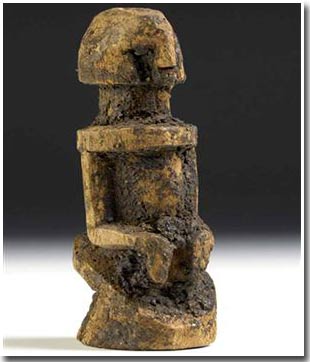Ancient statues covered with blood
Scientists claim that the Mali Empire's sculptors - a well-known wealthy empire and once a source of half the world's gold - have painted their sculptures with blood.
The Mali Empire lasted from the 13th century to the seventeenth century. In the heyday, this Empire had a larger area than Western Europe and was famous for its gold mines. Scientists had doubts about the existence of blood on ancient African relics related to the use of animals in sacrificial rituals. Although many relics with shells and polish water are thought to be made of blood, the time has gradually ruined these traces so it is difficult for scientists to confirm the assumption.

Statue of the Mali Empire (Photo: MSN)
Thanks to the application of modern technology, French scientists have identified blood stains on Mali sculptures. While this method cannot reveal this to be human blood or animal blood, interviews of anthropologists suggest that this is merely animal blood.
Evidence of authenticity
The object of the study is 8 statues of life expectancy from the 12th century to the 20th century. Three of them are the Dogon tribe, the other five are called Boliw , the sacred relics of the Bamana tribe are made of wood or bamboo simulating animals. The black crust of the statue is thought to be made of sacrificial blood along with a millet of millet, butter made from the fat of African shea butter or alcohol made from palm trees.
Investigators took samples of extremely small polishes from the statues, then these samples were irradiated with high-intensity molecular and light rays to minimize the damage. This method has identified chemical traces of blood, such as hemoglobin and iron binding to proteins on seven statues. There is no conclusion about the last statue.
Unique heritage
Chemical statues Pascale Richardin of the Center for Research and Restoration of Museums in Paris, France: These statues are the unique heritage of ancient rituals, which are considered an essential part of the background. African civilization. Knowledge of these gloss coatings will help explain rituals conducted for centuries.
The research results of Richardin and colleagues were published on the December 15 issue of Analytical Chemistry magazine.
- The mysterious magnetic field covered 10 ancient statues 2,000 years
- Detecting ancient phenomenon on the seabed of Cu Lao Cham
- Decipher the unusual statues of the year 1,400 years
- Why are ancient Greek statues naked?
- Discovered more than 3,000 years of pharaoh statues
- Find the ancient Roman statue at the underwater palace
- Discover 19 mysterious ancient statues in the clay city
- Egypt announced two giant pharaohs
- Techniques to help the ancient people put stone caps 13 tons on top of the statue
- Statue of stout woman over 10,000 years old
- The mystery of the statues that existed for 800 years made Chinese people fearful
- Detecting mysterious stone statues in China
 Discovered an ancient centipede fossil 99 million years old
Discovered an ancient centipede fossil 99 million years old Discovered bat-like dinosaurs in China
Discovered bat-like dinosaurs in China Discovered a 200-year-old bronze cannon of the coast
Discovered a 200-year-old bronze cannon of the coast Discover 305 million-year-old spider fossils
Discover 305 million-year-old spider fossils